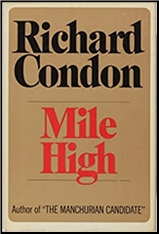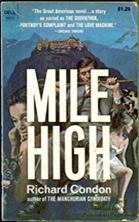Fri 23 Apr 2021
A 1001 Midnights Review: RICHARD CONDON – Mile High.
Posted by Steve under 1001 Midnights , Reviews[4] Comments
by Barry N. Malzberg
RICHARD CONDON – Mile High. Dial Press, hardcover, 1969. Dell, paperback, 1970.

In his strongest work — The Manchurian Candidate (1959), Winter Kills (1974) — Richard Condon has shown an unerring ability to find the hub throughout which the threads of American corruption, desire, insanity, politics, dread, and dreams pass, and to find that precise point of convergence which indicates that the history (and future) of the culture is as coherent and malevolent as death; in his weakest work, Condon has been a Boy Scout leader mumbling increasingly repellent horror stories around a fire to the wide-eyed troops, trying to give them a thrill at whatever cost.
Mile High is somewhere in the middle. It is as paranoid as The Manchurian Candidate but lacks its purity; it runs out of plot two-thirds of the way through and has to make do with an imposed and inauthentic suspense melodrama. Condon believes his generalities here but cannot pay attention to the particulars.
The premise is audacious, wholly workable, and possibly even correct (as correct as the brainwashed-and-programmed-human-time-bomb premise of The Manchurian Candidate, or the presidential-assassination premise of Winter Kills): American Prohibition was virtually the single-handed creation of one rich and brilliant businessman who knew that it would be great for the illegal liquor business and used his. modest inherited assets to build a network that, in its complexity, virtually overtook the country. When Prohibition finally collapses, Edward Courance West is worth many hundreds of billions of dollars (and it is his consolidation of widely held assets into hard cash that causes the depression).

West, however, is an unstable personality; abandoned by his mother, a. dark Italian, in his childhood, he must replicate the abandonment by wreaking terrible vengeance upon his black mistresses. His psychosis leads to murder and to his. removal from American society to a mile-high palace in the central Adirondacks. Here, aging, monumentally rich, safe and mad, West raves to his lifelong manservant, Willie Tobin, of the Communist peril and the rise of “the terrible black hordes” that are his alone to combat. (There is not a cause of the lunatic right to which he will not subscribe millions of dollars.)
Good enough to this point (or bad enough), and a serviceable, often terrifying roman à clef of several figures in mid-century American life; but there is an imposed and highly coincidental subplot dealing with the black artist wife of West’s second son (the point of view character of the unnecessary middle section of the novel) who reminds West of his mother and of the black women in whose image murder was committed.
Having run out its exposition and its implication, Mile High turns into a somewhat clumsy (and clumsily transparent) novel of menace and oversimplifies ultimately; West’s “insanity” is the hole through which the book’s true implication and terror drain. West becomes merely a symbol, and unfortunately, the novel “symbolic” rather than the horrifying near-documentary that Winter Kills is.
Still, Condon’s pacing, portentousness, and Clemens-like contempt for the human condition come through and sustain the narrative. At half its 160,000-word length, Mile High might have been a tormented, glacial vision: a century of history compressed to nightmare.
———
Reprinted with permission from 1001 Midnights, edited by Bill Pronzini & Marcia Muller and published by The Battered Silicon Dispatch Box, 2007. Copyright © 1986, 2007 by the Pronzini-Muller Family Trust.
April 23rd, 2021 at 7:58 pm
Mid level Condon is accurate. Interesting rather than involving save on a superficial level and not quite the bite of his best work whether serious or satiric. Still it is Condon, and at least a ‘mile high” above any competitors.
April 23rd, 2021 at 8:06 pm
A book I don’t remember ever seeing or even reading about before. I am surprised that I don’t remember the paperback, as it came out during the period when I scoured the mystery section of every bookstore I was in, from top to bottom, whether used or new. I wonder if it was always shelved with the mainstream fiction, either way.
April 23rd, 2021 at 8:26 pm
By then Condon was with the bestsellers.
April 23rd, 2021 at 10:20 pm
Right. And ignored by me.